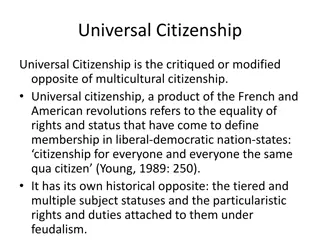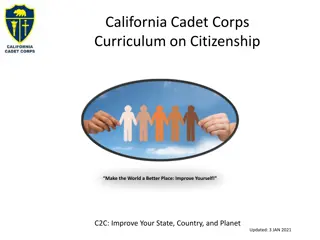Understanding Citizenship Models and Welfare Development
Explore the concept of citizenship within the context of state development, focusing on elements such as population, territory, government, and sovereignty. Learn about the three kinds of population in a state - aliens, subjects, and citizens - and how they differ in terms of rights. Discover the Citizenship Model of Social Welfare, which emphasizes civil, political, and social rights as essential components of full membership in society.
Download Presentation

Please find below an Image/Link to download the presentation.
The content on the website is provided AS IS for your information and personal use only. It may not be sold, licensed, or shared on other websites without obtaining consent from the author. Download presentation by click this link. If you encounter any issues during the download, it is possible that the publisher has removed the file from their server.
E N D
Presentation Transcript
Citizenship Model of Welfare Development
Elements of State 1. Population 2. Territory 3. Government 4. Sovereignty POPULATION 1. Aliens 2. Subjects 3. Citizens The state is a form of human association distinguished from other social groups by 1. its purpose, the establishment of order and security; 2. its methods, the laws and their enforcement; 3. its territory, the area of jurisdiction or geographic boundaries; and 4. finally by its sovereignty
Three kinds of Population in a State Aliens : No Political Some Civil Rights Some Social Rights Subjects: Some Political Full Civil Rights Some Social Rights Citizens: Full Political Full Civil Rights Full Social Rights 1. Aliens Subjects Citizens Political Rights No Some Full 2. Civil Rights Some Full Full Social Rights 3. Some Some Full
Citizenship Model of Social Welfare The concept is based upon the work of 19th century Economist Alfred Marshal s hypothesis advanced by T.H. Marshal in 1963. Alfred Marshal was of the opinion that human equality is associated with the concept of full membership of a society or community, which is contingent on the individual s possessions of three sets of citizen rights: Civil rights, Political rights and Social rights. He has explained these rights as[1]; [1] T.H. Marshal,1963 . Citizenship and Social Class in Sociology at Crossroad Cf. Sullivan. Op. Cit. P. 70.
1. Civil rights; are those rights concerned with individual liberty and include freedom of speech and thought, the right to own private property and the right to justice; 2. Political rights; are primarily those rights of participation in the political process of government, either as an elector or as an elected member of an assembly; 3. Social rights; cover a whole range of rights from the right to a modicum of economic security through to the right to share in the heritage and living standards of a civilized society.
Marshal sees state provided social welfare as a part and parcel of the package of social rights, which are an element of the rights of citizenship.
The first led to the establishment of legal institutions. The second to political institutions. The third to the institutionalization of welfare[1] or statutory welfare Civil Rights Political Rights Social Rights Legal Institutions Political Institutions Social Welfare Institution Political Parties/National Assembly etc BISP, PBM, Woman Welfare, Child Protection Commission, etc. Courts [1] Ramesh Mishra, 1981. Society and Social Policy: Theories and Practice of Social Welfare Cf. H.Y.Siddiqui. Op.Cit.p.5.
Aim and Function of Social Welfare? The aims and functions of social welfare under this approach can be described as the material equality through redistribution.
Criticism Experts like Crosland (1956), criticize this aim and function of social welfare and assert that the aims and functions of state welfare are not primarily those of equality through redistribution[1]. According to him, Social equality cannot be held to be the ultimate purpose of the social services rather, the aims are to provide relief of social distress* and the correction of social needs. Inequalities will be lessened as a result, but the creation of equality is, at most, a subsidiary objective. *lack of basic necessities Relief: public help in the form of money, food, clothing, shelter, or medicine, provided to people who are temporarily unable to care for themselves [1] C.A. R., Crosland, 1956. The Future of Socialism. London: Jonathan Cape.p.148.























